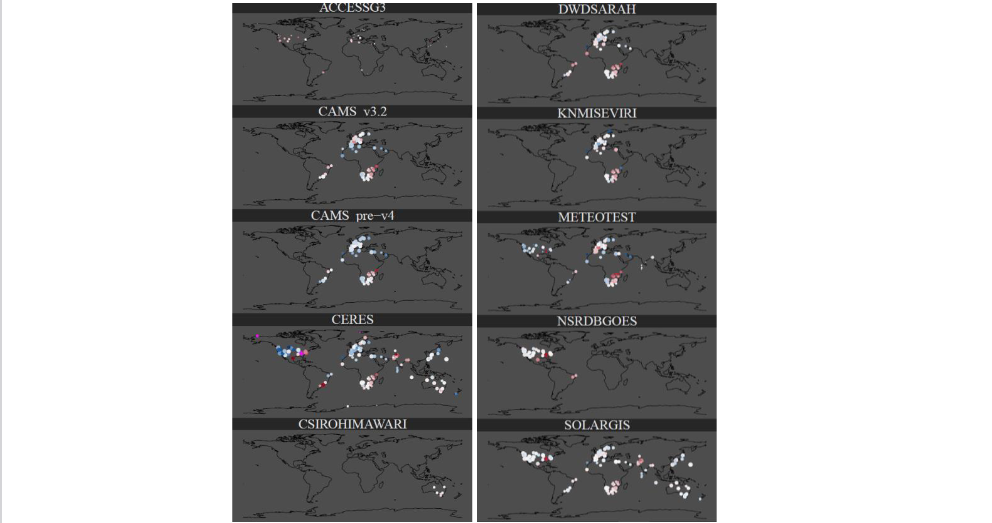From pv magazine Global
Solar irradiance plays a crucial role in managing PV assets throughout the world. Numerous institutional and commercial providers offer modeled solar irradiance data, making it challenging for users to determine the most suitable providers for their specific applications and locations.
Now, IEA-PVPS Task 16 has produced a worldwide benchmark of modeled solar irradiance data to help the solar industry to make better-informed decisions about solar resource assessments.
The study gives a point of reference for model-derived direct normal irradiance (DNI) and global horizontal irradiance (GHI) data, using 129 high-quality ground-based radiation measurement stations across the globe from 2015 to 2020. It then compares DNI and GHI estimates from 10 solar radiation datasets, either public-domain or commercial, against this reference point. The datasets are ACCESSG3, DWDSARAH, CAMS v3.2, KNMISEVIRI, CAMS pre-v4, METEOTEST, CERES, NSRDBGOES, CSIROHIMAWARI, and Solargis.
The comparison is conducted at hourly temporal resolution and the performance of the modeled information is analyzed with respect to different regions and climate zones.
IEA-PVPS says the quality of the reference database is assured by selecting data based on a “comprehensive set of best practices and newly implemented quality-control procedures. These include automatic and manual data quality-control tests carried out by a team of experts for all stations and result in flags describing the quality for each time stamp.” Of the total 129 stations, 31 are in Africa, 31 in Asia, 27 in North America, 20 in Europe, 13 in Australia, five in South America, and two in Antarctica. The report calculates the mean bias deviation, root mean square deviation, and standard deviation between the benchmark and each station across the 2015-20 period.
“The benchmark results have shown noticeable deviations in performance between the various modeled data sets,” the report says. “In particular, it was found that the most appropriate data set actually depends on both site and climate or continent of interest. Some stations are especially challenging for some models, as evidenced by the high deviations observed for several data sets in difficult environments (e.g., high mountains or coastal areas).”
The report showed that the model errors and the differences between the various modeled data sets are much higher for DNI than for GHI, because of the former’s higher sensitivity to aerosols, clouds, and elevation, among other factors.
As for dataset-specific results, the study shows that CERES had significantly higher deviations than all other satellite-derived datasets, likely due to its coarser resolution. Solargis showed the lowest average deviation metrics and was also the best performer at many individual stations, according to IEA-PVPS.
“From a methodological standpoint, this benchmark underlined the importance of the reference data quality. Without a stringent quality control procedure, no real validation can be done, with the risk of obtaining invalid results,” the researchers concluded.
This content is protected by copyright and may not be reused. If you want to cooperate with us and would like to reuse some of our content, please contact: editors@pv-magazine.com.








By submitting this form you agree to pv magazine using your data for the purposes of publishing your comment.
Your personal data will only be disclosed or otherwise transmitted to third parties for the purposes of spam filtering or if this is necessary for technical maintenance of the website. Any other transfer to third parties will not take place unless this is justified on the basis of applicable data protection regulations or if pv magazine is legally obliged to do so.
You may revoke this consent at any time with effect for the future, in which case your personal data will be deleted immediately. Otherwise, your data will be deleted if pv magazine has processed your request or the purpose of data storage is fulfilled.
Further information on data privacy can be found in our Data Protection Policy.